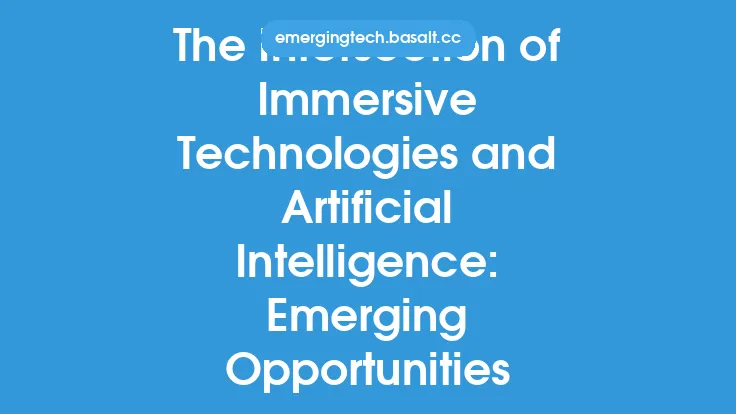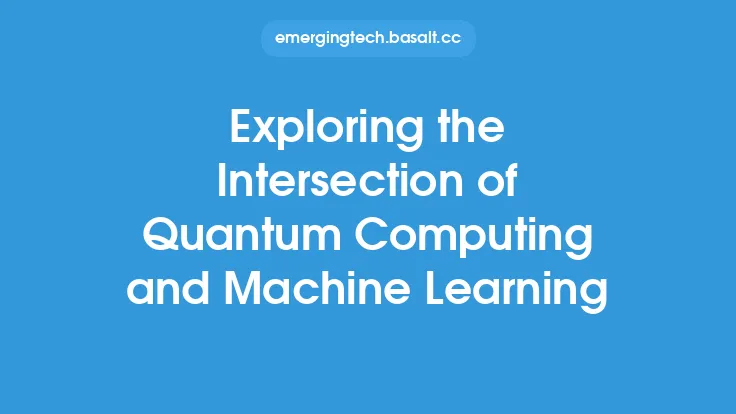The concept of spatial computing has been gaining significant attention in recent years, particularly with the advancement of technologies such as virtual and augmented reality. At its core, spatial computing refers to the ability of computers to understand and interact with the physical world in a more human-like way. This involves the use of various sensors, cameras, and other devices to perceive and interpret spatial information, allowing computers to make sense of their surroundings and respond accordingly. One of the key technologies that has been instrumental in advancing the field of spatial computing is artificial intelligence (AI).
Introduction to Artificial Intelligence in Spatial Computing
Artificial intelligence plays a crucial role in spatial computing, as it enables computers to learn from and adapt to their environment. AI algorithms can be used to analyze the vast amounts of data generated by spatial sensors, such as 3D models, images, and videos, and extract meaningful information from them. This information can then be used to inform the computer's decision-making processes, allowing it to interact with the physical world in a more intelligent and autonomous way. For example, AI-powered spatial computing systems can be used to recognize and track objects, people, and animals, and respond accordingly. This has numerous applications in fields such as robotics, autonomous vehicles, and smart homes.
Computer Vision and Machine Learning
Two of the key technologies that underpin the intersection of spatial computing and AI are computer vision and machine learning. Computer vision refers to the ability of computers to interpret and understand visual data from the world around them. This involves the use of cameras, sensors, and other devices to capture images and videos, which are then analyzed using AI algorithms to extract meaningful information. Machine learning, on the other hand, refers to the ability of computers to learn from data and improve their performance over time. In the context of spatial computing, machine learning algorithms can be used to analyze the data generated by spatial sensors and improve the computer's ability to understand and interact with the physical world.
Spatial Reasoning and Awareness
Another key aspect of the intersection of spatial computing and AI is spatial reasoning and awareness. Spatial reasoning refers to the ability of computers to understand the relationships between objects in space, and to reason about the physical world in a more human-like way. This involves the use of AI algorithms to analyze the data generated by spatial sensors, and to extract meaningful information about the environment. Spatial awareness, on the other hand, refers to the ability of computers to understand their own position and orientation in space, and to navigate their surroundings accordingly. This has numerous applications in fields such as robotics, autonomous vehicles, and virtual reality.
Applications of Spatial Computing and AI
The intersection of spatial computing and AI has numerous applications in a wide range of fields. For example, in the field of robotics, spatial computing and AI can be used to enable robots to navigate and interact with their surroundings in a more intelligent and autonomous way. In the field of autonomous vehicles, spatial computing and AI can be used to enable vehicles to perceive and respond to their environment, and to navigate through complex scenarios such as intersections and roundabouts. In the field of virtual reality, spatial computing and AI can be used to create more immersive and interactive experiences, such as virtual environments that respond to the user's movements and actions.
Technical Challenges and Limitations
Despite the numerous applications and benefits of the intersection of spatial computing and AI, there are also several technical challenges and limitations that must be addressed. For example, one of the key challenges is the need for high-quality spatial data, which can be difficult to obtain in certain environments such as indoors or in areas with limited visibility. Another challenge is the need for powerful computing resources, which can be difficult to achieve in certain applications such as robotics or autonomous vehicles. Additionally, there are also several limitations related to the accuracy and reliability of AI algorithms, which can be affected by factors such as noise, bias, and variability in the data.
Future Directions and Opportunities
Despite the technical challenges and limitations, the intersection of spatial computing and AI is a rapidly evolving field with numerous future directions and opportunities. For example, one of the key areas of research is the development of more advanced AI algorithms that can learn from and adapt to complex spatial data. Another area of research is the development of more sophisticated spatial sensors and devices, such as 3D cameras and lidar sensors, which can provide higher-quality spatial data. Additionally, there are also several opportunities for the application of spatial computing and AI in new and emerging fields, such as smart cities, intelligent buildings, and environmental monitoring.
Conclusion and Summary
In conclusion, the intersection of spatial computing and AI is a rapidly evolving field with numerous applications and benefits. By leveraging the power of AI algorithms and spatial sensors, computers can be enabled to understand and interact with the physical world in a more human-like way. While there are several technical challenges and limitations that must be addressed, the future directions and opportunities for this field are numerous and exciting. As the technology continues to advance and improve, we can expect to see more sophisticated and autonomous spatial computing systems that can perceive, reason, and interact with the physical world in a more intelligent and adaptive way.





